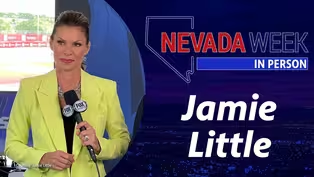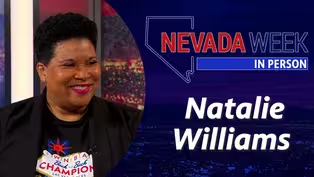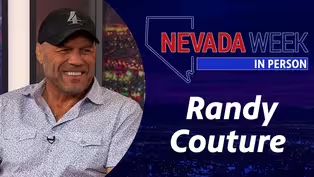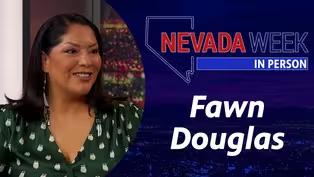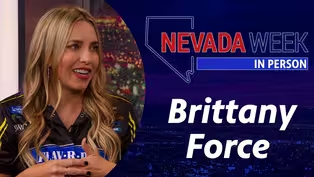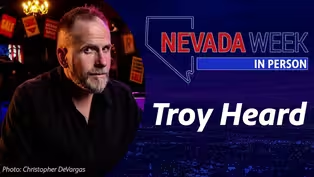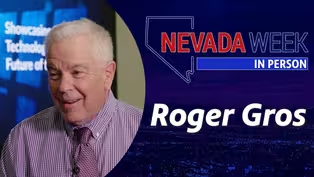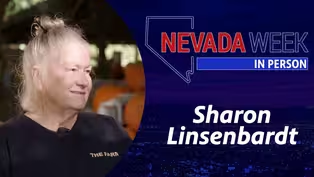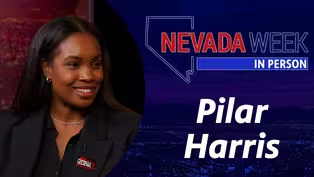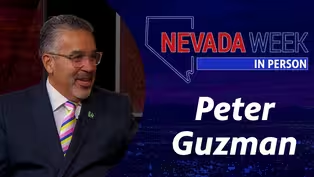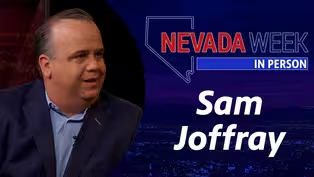
Nevada Week In Person | Su Kim Chung
Season 1 Episode 61 | 14mVideo has Closed Captions
One-on-one interview with Su Kim Chung from UNLV Special Collections.
One-on-one interview with Su Kim Chung from UNLV Special Collections.
Problems playing video? | Closed Captioning Feedback
Problems playing video? | Closed Captioning Feedback
Nevada Week In Person is a local public television program presented by Vegas PBS

Nevada Week In Person | Su Kim Chung
Season 1 Episode 61 | 14mVideo has Closed Captions
One-on-one interview with Su Kim Chung from UNLV Special Collections.
Problems playing video? | Closed Captioning Feedback
How to Watch Nevada Week In Person
Nevada Week In Person is available to stream on pbs.org and the free PBS App, available on iPhone, Apple TV, Android TV, Android smartphones, Amazon Fire TV, Amazon Fire Tablet, Roku, Samsung Smart TV, and Vizio.
Providing Support for PBS.org
Learn Moreabout PBS online sponsorshipMore from This Collection
Nevada Week In Person goes beyond the roundtable discussion of Nevada Week with guests for a more casual conversation about their personal passions, new projects and compelling stories that are overlooked in the flurry of the news cycle.
Nevada Week In Person | Jamie Little
Video has Closed Captions
One-on-one interview with Jamie Little, NASCAR Broadcaster (14m)
Nevada Week In Person | Chet Buchanan
Video has Closed Captions
One-on-one interview with Chet Buchanan,Host & Creator, 98.5 KLUC’s The Chet Buchanan Show (14m)
Nevada Week In Person | Natalie Williams
Video has Closed Captions
One-on-one interview with Natalie Williams, General Manager, Las Vegas Aces (14m)
Nevada Week In Person | Randy Couture
Video has Closed Captions
One-on-one interview with Randy Couture, UFC Hall of Famer & U.S. Army Veteran (14m)
Nevada Week In Person | Fawn Douglas
Video has Closed Captions
One-on-one interview with Fawn Douglas, Artist and Activist, Nuwu Art (14m)
Nevada Week In Person | Brittany Force
Video has Closed Captions
One-on-one interview with Brittany Force, World Champion Drag Racer (14m)
Nevada Week In Person | Troy Heard
Video has Closed Captions
One-on-one interview with Troy Heard, Artistic Director, Majestic Repertory Theatre (14m)
Nevada Week In Person | Roger Gros
Video has Closed Captions
One-on-one interview with Roger Gros, Publisher, Global Gaming Business Magazine (14m)
Video has Closed Captions
One-on-one interview with Sharon Linsenbardt, Owner, Las Vegas Farm and Barn Buddies Rescu (14m)
Nevada Week In Person | Pilar Harris
Video has Closed Captions
One-on-one interview with Pilar Harris (14m)
Nevada Week In Person | Peter Guzman
Video has Closed Captions
One-on-one interview with Latin Chamber of Commerce Nevada President & CEO Peter Guzman (14m)
Nevada Week In Person | Sam Joffray
Video has Closed Captions
One-on-one interview with Sam Joffray, President & CEO, Las Vegas Super Bowl LVII Host Com (14m)
Providing Support for PBS.org
Learn Moreabout PBS online sponsorshipHer job is to collect and document the history of Las Vegas at the UNLV Library, Special Collections and Archives division.
Su Kim Chung on the history of Las Vegas and how she is working to preserve it.
♪♪♪ Support for Nevada Week In Person is provided by Senator William H. Hernstadt.
(Maria Silva) Welcome to Nevada Week In Person .
I'm Maria Silva, in for Amber Renee Dixon who is out on maternity leave.
Thank you so much for joining us.
Well, her field of expertise include Las Vegas in Southern Nevada history, Las Vegas' entertainment, and showgirls.
Yes, you heard right, show girls.
Our In Person guest is, this week-- She works to collect, archive, and preserve some of our city's rich history, especially as we mentioned, our entertainment history.
Su Kim Chung, welcome to Nevada Week In Person .
(Su Kim Chung) Thanks for having me.
-Thanks for joining us.
You have a fascinating job.
Tell us a little bit about what you do.
-So I'm the head of public services, so I work with reference instruction and outreach.
And I also curate historical collections.
I reach out to people in the community to collect material in entertainment history, women's history, and LGBTQ history as well.
-And let's talk about your love for our city.
You have this beautiful book, Las Vegas Then and Now .
When did your fascination with our city, our dynamic Las Vegas, start?
-Well, I came here in 1999 for my job as a manuscripts librarian in Special Collections and Archives.
And I had been-- I had studied European history in college, and I really didn't know anything about Las Vegas' history.
But I soon really got absorbed in it.
I was working with historical documents and photographs every day.
So I started in 1999, and they first approached me to do Las Vegas Then and Now in 2001.
And so I didn't know the city as well.
But of course, I was getting to learn more about it.
And I was able to look at the historical photographs in our collection.
So that book is actually, there has now been-- It's on its sixth-- fifth edition.
And we've been doing it for 20 years.
So there have been tremendous changes.
So if you were to look at the first edition of it, it would look very different from the edition today because it's changed so much over the years.
-And let's talk about from that first edition to now, the fifth edition, what is no longer around?
-Oh gosh, the Stardust, the Riviera.
Gosh, there are-- Downtown, the Las Vegas Club is gone, replaced by Circa.
Well, the Sahara went through its transition to the SLS, back to the Sahara.
So lots and lots of changes that I've seen.
And those are kind of two of the biggest ones.
And the Frontier Hotel was also-- when I first wrote the book in 2002, the Frontier Hotel was still there.
Now it's a, it's a vacant-- it's a dirt lot.
-Now, we were talking off camera.
With this edition, you were able to include something that's very near and dear to your heart.
Tell me about that.
-So typically, a lot of the scenes and the spreads in the book have focused on the Las Vegas Strip and Fremont Street.
So they're things that are very familiar to tourists.
And I, this time, I wanted to feature something that was a little bit more for the community.
Not that it isn't appealing to tourists as well, but I asked if we could include the Arts District.
And the publisher is based in London.
So they really don't know a lot of the ins and outs of Las Vegas as much as I do.
So I asked about the Arts District, and I found, I found some-- worked with some people who have businesses in the Arts District, and I found some historic photographs.
And "historic" meaning maybe 10 years ago or so, before it became the thriving cultural center we see today on Main Street.
So Main Street when it was more industrial, when there were more auto body shops and things like that.
So I got some wonderful historic images.
So we were able to actually do two full spreads on the Arts District.
So I was thrilled about that, to feature some of the public art and the transformations of some of the industrial businesses into like thriving, like restaurants today and clothing and different kinds of retail outlets as well.
-And what I do love about this book are those photos, thoses photographs then and now.
They're beautiful.
-Yeah.
I can't take credit for the photos because they do have a photographer that comes.
But for the historic photos, we do select from the archives, which are, it's a really fun, fun thing to do.
-Another great thing that you mentioned here, and again, it's fascinating to me that your fascination was showgirls.
Where did that come about?
What made you think, You know what?
This is a big part of Las Vegas' history.
I'm going to look into this.
-Well, partly it's because of my work.
One of the very first collections that I worked on and processed and described was the papers of Donn Arden, who was of course, a world famous producer of shows, of cabaret shows, who was responsible for Jubilee and the Lido de Paris and the Hallelujah Hollywood .
And I also made a friend, my very first friend that I made in Las Vegas was a showgirl who worked at Jubilee .
So we-- I had this sort of connection, and I learned about it from that angle.
And then I learned about it historically.
So that's kind of where my fascination has led me.
And I now, I regularly-- I reach out to people in the community or beyond Las Vegas, and people reach out to me to potentially donate materials to really document because, as we know, there are no more showgirl shows on the Strip.
So I regularly do panels at the Clark County Library in conjunction with Special Collections where I interview people, past performers.
And we relive those days on stage for the people and people in the audience as well.
-And that's part of your oral history project that you did, and can we have access to that?
Can we look into that because, I mean, I'm fascinated.
-We have individual-- I have done individual oral histories with dancers and also-- And other people in my division.
My colleague Claytee White has also done interviews with dancers as well.
These are a little bit different, because I had-- they're sort of a live oral history.
It's three people on stage that may have danced in a particular show, maybe they've worked backstage, maybe they've been a specialty act.
So they're kind of on stage.
And so they're a little different than a one-on-one oral history, but they're still-- they're a lot of fun because there's a lot of people in the audience who may not have seen that performer since they were on stage 20 years ago.
And so it's always a big reunion atmosphere at my panels, because people are so excited to see people they may have not seen for decades.
-Now you wrote something in an article.
You wrote for Nevada Magazine .
You wrote, "She was a city icon who helped Las Vegas become the entertainment capital of the world.
The showgirl is a distant memory for most, but there is hope that she will one day return to the stage."
Do you ever see that happening?
-You know, it's really difficult to-- I think it's a matter of, and I think there are other people in the entertainment industry who would be better suited to be, you know, provide you with the definitive answer.
But we know that those shows cost, you know, tens of millions of dollars to produce.
And at the time when they were done in the 50s and 60s and 70s and 80s, sometimes they were loss-leaders for the casino.
So you would come in to see the show, but then you would end up gambling.
So they kind of relied on maybe if they didn't make money because they had to put out a lot of money to produce the show, they had somebody that was going to come in, you know, a couple was-- husband and wife was going to come in to see the costumes and the beautiful dancers and show girls, and then the husband or wife would gamble.
So they would kind of make up that money.
So it's a little bit different today.
You know, the shows kind of are self sufficient, and they have to be produced.
So not a lot of people have that, that amount of budget to create one of those big production shows.
I mean, we still have-- we still see showgirls.
And I don't mean the women who walk down the Strip soliciting photographs.
I mean the Golden Knights have the Golden Bells, who are a lot of former Jubilee dancers, are part of the Golden Bells.
And there are certain, I think, agencies around town that employ former dancers and showgirls to serve, to be part of conventions and, and things like that.
I think there's still the talent out there as we can see from those shows like So You Think You Can Dance and a lot of-- there are lots of people with the talent and who've studied professional dance.
And I think there's probably people out there that could maybe update a show and do the choreography and the producing.
It's just I don't know if it's a matter of financing, but I would hope one day maybe there will be a smaller lounge show that features showgirls.
-You never know.
-Like Vive Les Girls .
That was a famous show in the late '60s at the Dunes that was choreographed by Ron Lewis.
-Oh, I love that.
And it is fascinating, and it is-- I remember working for a lovely, when I was at the MGM, Janet Spelman, Ford Spelman.
You probably know her.
-Yes.
She was one of the beautiful principals in Jubilee .
She was one of the very first principals in Jubilee when it opened in 1981.
-Can I tell-- I was her assistant at the MGM, and I remember she would glide into the room with such grace and elegance, and she was tall, blonde, gorgeous, and stunning.
And again, she was just the kindest person.
But I love that there's that close knit community.
I looked her up, and I saw that there was a group photo of all of them coming together for the last show.
-And she was on one of my panels I did for the 40th anniversary of the opening of Jubilee in 2021.
I did a panel that featured her and Tricia Leibovici, who was also a principal.
So it was Janet and Tricia and then Diana Eden, who was the assistant to Bob Mackie who was the costume designer for the finale.
So we did one of our panels at the, at the Clark County Library.
-Hi, Janet.
She's amazing.
So much history here, her family as well, with her mom as well.
-Yes.
Her mom is a part of our Nevada Women's archives.
She was an amazing woman who did a lot.
Created basically the Women's Studies Department up at UNR, and she also was responsible for a lot of work with the Nevada Women's History Project and the Nevada Women's Archive.
-Assemblywoman-- -Yes.
Exactly.
-Her legacy lives on that way.
-Yes.
-Now let's talk a little bit about Nevada, women here in Nevada.
I was also fascinated to learn that you did your dissertation, correct, on Jeanne Wier, who just so happens to be-- she was the founder of the Nevada Historical Society which is so fascinating?
When did that happen, back in the day and the fact that she was already a trailblazer?
-Yeah, so this was a 1904.
She was one of several founders, but she was the first secretary for the Nevada Historical Society up in Reno, which was the first repository for historical materials and cultural heritage in the state.
So that was 1904.
And back East-- I mean, I had to do, because I did my dissertation on this, I know that in back East, the historical societies were generally a men's domain.
So I think Nevada is a trailblazer in that our Historical Society was headed by a woman who has really dedicated her life to the history of Nevada.
And it was really due to her work and perseverance and traveling all over the state.
And mind you, she had-- Her full-time day job, she was a professor of history at then University of Nevada.
And during her off hours on the weekend and during the summer, she would travel around the state, including Las Vegas in 1908, I believe.
She would travel around, and she would solicit historical materials.
-And she did such a phenomenal job.
-Yeah.
-Her red journal that you wrote about here in Flies Millions Thick .
That's fascinating that you wrote this and you document just from July through August of 1908.
But it's just so fascinating.
-Yes.
She came to-- she came from Reno all the way down to Central and Southern Nevada.
She met with some of the big movers and shakers.
She met Helen Stewart.
She met Walter Bracken.
She went all over Southern Nevada in the attempt to collect history at a time when we were a very young city.
We weren't even really incorporated.
It was 1908.
So, you know, the land auction had only taken place in 1905.
It was a very young city, but she saw the importance of documenting the whole state and including Southern Nevada at a time when Las Vegas was really very, very tiny, when the population of Goldfield and Tonopah was much higher than the population of Las Vegas.
-Fascinating.
She was also involved in the suffrage movement.
-Yes.
-So she was just great.
And I love that you wrote about her, and I love that someday someone will be writing about you as well, your legacy and the history books.
When I write those history books, how would you like to be remembered?
-Well, I guess I'd like to be remembered like Jeanne, as somebody who cared about the state.
And we're both people who kind of adopted the state as our home.
She came from Iowa, and I came from California.
Don't hate me for that.
-We don't.
-And that came to really love the state and everything it represents and all the important people who've made a contribution to the history of Nevada.
-Well, thank you.
Thank you for loving a city that I grew up in as much as I do.
And thank you for what you're doing.
Again, this wonderful book right now, Las Vegas Then and Now , you can get this online.
Su Kim Chung, thanks again for joining us.
-You're welcome.
Thanks for having me.
-It was just fascinating.
And thank you at home for joining us for Nevada Week In Person .
To see more of Nevada Week In Person , as well as this week's edition of Nevada Week , go to vegaspbs.org/nevadaweek.
A beautiful book.
♪♪♪

- News and Public Affairs

Top journalists deliver compelling original analysis of the hour's headlines.

- News and Public Affairs

FRONTLINE is investigative journalism that questions, explains and changes our world.












Support for PBS provided by:
Nevada Week In Person is a local public television program presented by Vegas PBS
